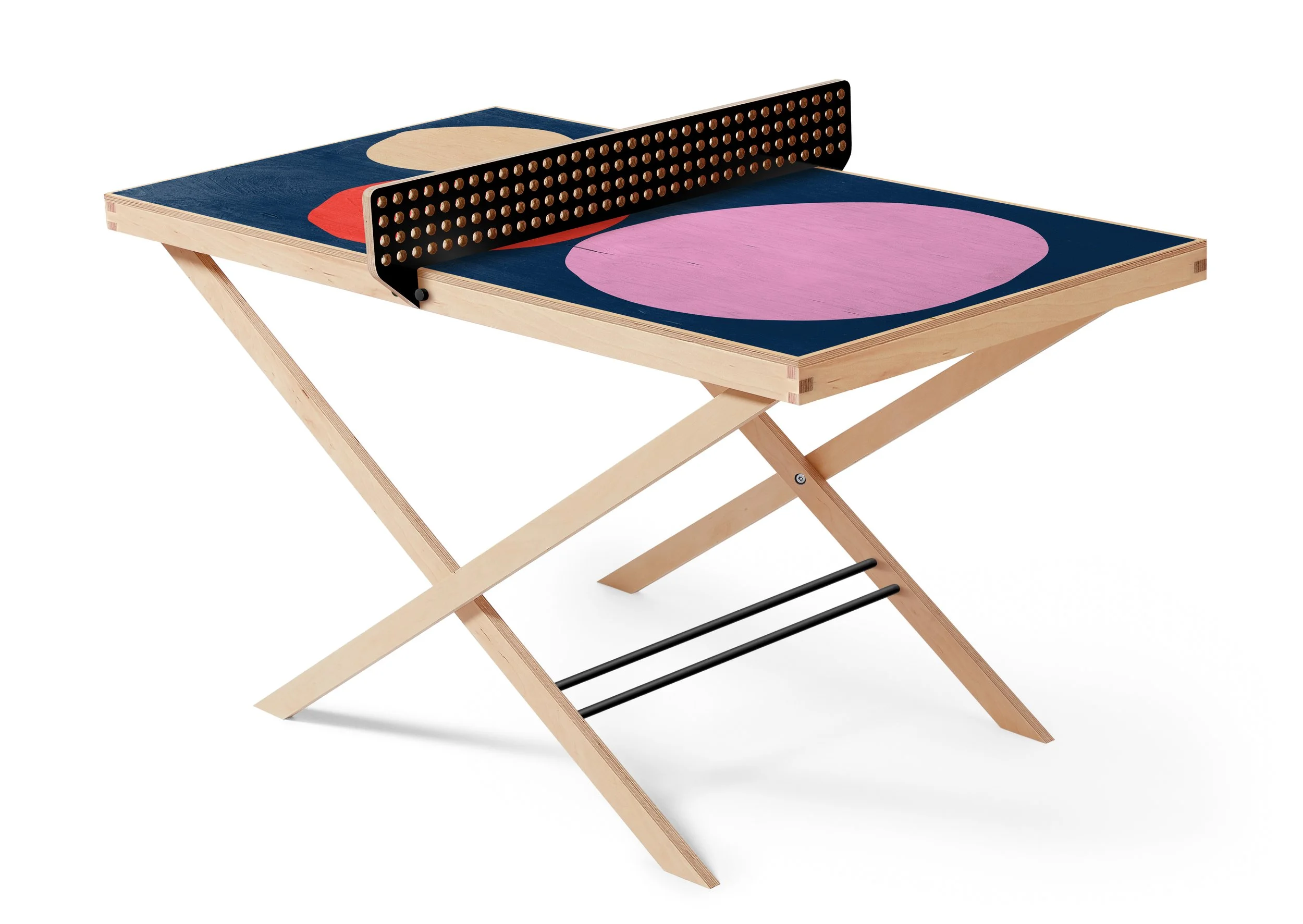Art of Ping Pong: Hang It. Play It. Love It.
Caroline Moorhouse and Algy Batten
All across London, and in select enclaves the world over, hang limited edition artworks hot from the studio of Algy Batten and Caroline Moorhouse.
But these are no ordinary pieces. Should your host be in the right mood, you might find the art jumps off the wall and literally sprouts legs. Their company, Art of Ping Pong (AoPP), produces wall-hanging ping pong tables in partnership with contemporary artists.
The founders of Art of Ping Pong in front of one of their wall-hanging tables
The result is functional and decorative: a high-quality wooden table featuring exclusive artwork that can be mounted as decorations or used for games. ‘A regular fold-away table can be a big, ugly-looking thing,’ Batten laments. It’s his creativity that transformed this frustration into a fusion of art, play, and connection.
Should your host be in the right mood, you might find the art jumps off the wall and literally sprouts legs.
In a previous life Batten was co-founder of the design agency Fivefootsix, with years of experience in the creative sector. A traditional ping pong table stood in Fivefootsix’s office, but when Batten and his co-founder parted ways in 2015, there was nowhere for it to go. Closing a company involves many moving parts, and that particular void caught him off guard. ‘I hadn’t anticipated it,’ he shares.
Bringing a table – even a mini one – into his home would take up too much space, plus it’s something of an eyesore. ‘You have to think about how it’s stored, as they aren’t being played all day long.’ So, he decided to make a table that could be hung up when it wasn’t in use, something that was also ‘a work of art.’
His first try was a winning shot. Working on another exhibition in 2017, he decided to include his novel creation. A fellow table tennis enthusiast took a shine to it, and Batten found himself in an hour-long match with fashion designer Nigel Cabourn, who was ready to place a custom order there and then. ‘But I’d auctioned it for charity already,’ Batten shares. Cabourn insisted, pushing Batten to refine and expand on the concept.
‘There’s always a “reveal” moment. Someone takes it off the wall and goes: “You can play with it?!’”
Batten and his partner, Caroline Moorhouse, teamed up to see where this idea could go... and things moved fast. Even when they’d just launched their Instagram, they were fielding requests from major brands like Selfridges, who wanted a whopping twelve tables. ‘I thought Christ, I’ve only made two tables! But why the hell not?’ Batten says.
‘Talking Heads’ art table
In the eight years since AoPP’s beginnings, Batten still loves seeing the awe on people’s faces. ‘There’s always a “reveal” moment. Someone takes it off the wall and goes: “You can play with it?!’” Other comments have been memorably bombastic, ‘Someone once said it’s the best thing they’ve seen since the James Bond car turned into a boat.’
The unique wood grain in each table shows through the layered ink depths, creating one-of-a-kind designs. ‘Subtle knots, grain vibrancy... it makes every table feel alive,’ he explains. Multiple customers have shared that they treat the tables as heirlooms, not just playthings.
‘Someone once said it’s the best thing they’ve seen since the James Bond car turned into a boat!’
This dedication to quality is responsible for their organic growth. ‘It really just ran away with itself,’ he shrugs. Despite brimming with vision for where AoPP can go next, Batten never loses sight of what makes the company special. ‘We’re going slowly,’ he says, ‘we want to do things we’re proud of, and to avoid mass-production.’
Meanwhile, the focus on playfulness has only fuelled his desire to collaborate with new artists. While always making tables, AoPP has expanded its range to innovative paddles and sling bags. Batten has teamed up with creatives such as James Joyce, Kelly Anna, and André Saraiva, as well as legacy fashion houses like Dior and Pucci.
AoPP is now reuniting with sustainable fashion designer Christopher Raeburn, on sling bags made from discarded military materials. Each artist brings fresh aesthetics to the wooden canvas, merging creative identities with play.
Customers have shared that they treat the tables as heirlooms, as much as playthings.
LOST ART aficionados may recognise a familiar face on an AoPP table soon. We’ll be auctioning off a Bobu table – and there’s only ever going to be one made. ‘I’m super excited to see how it goes down, because it’s very different from what we’ve done before,’ Batten says.
Custom ‘Bobu’ art table designed for LOST ART by Luis Figueiredo
Our Bobu design is a great experiment – for it taps into a new world, and Batten has always seen the tables as a medium to spread joy in new places. ‘If you can interact and play with art, that makes it greater, in my opinion. If that connects you to something or someone else.’
‘Most start-ups are conscious decisions,’ Batten continues. But what started with a hobby and a wacky experiment has become an injection of merriment into the oh-so-serious art world. ‘It definitely wasn’t easy to get such a strange, new concept off the ground’, he says. ‘It’s hard to explain. But when people get it, they love it.’
All images courtesy of Art of Ping Pong.





